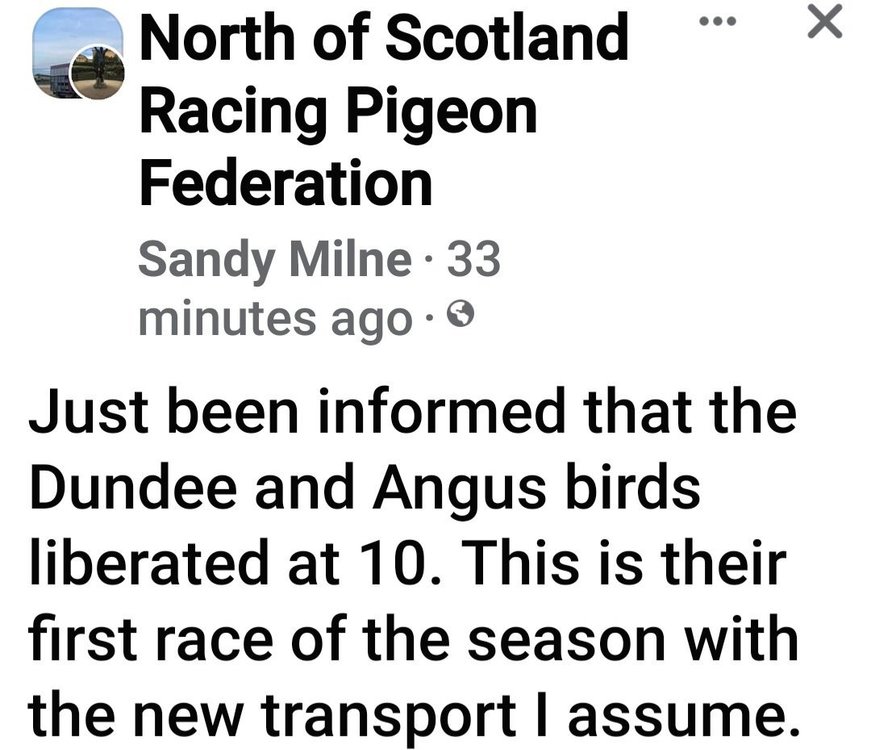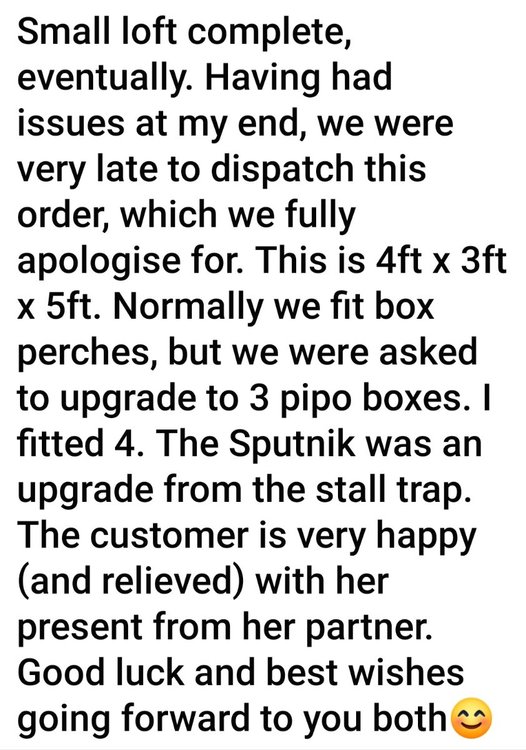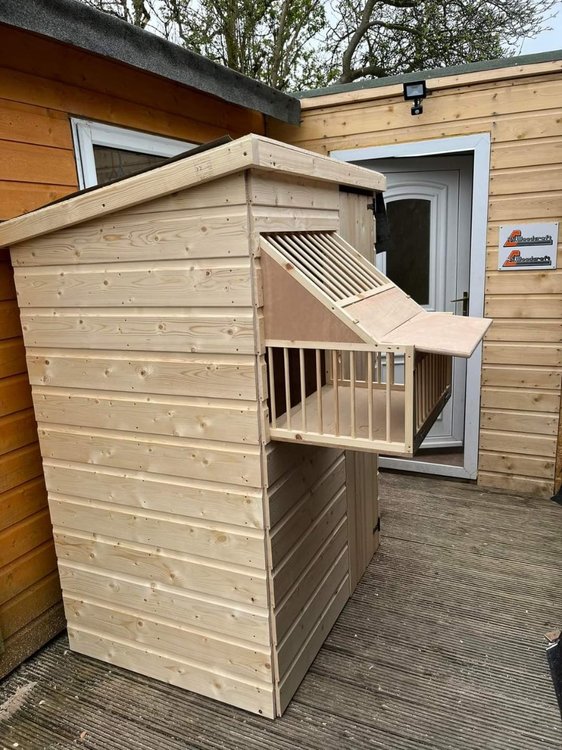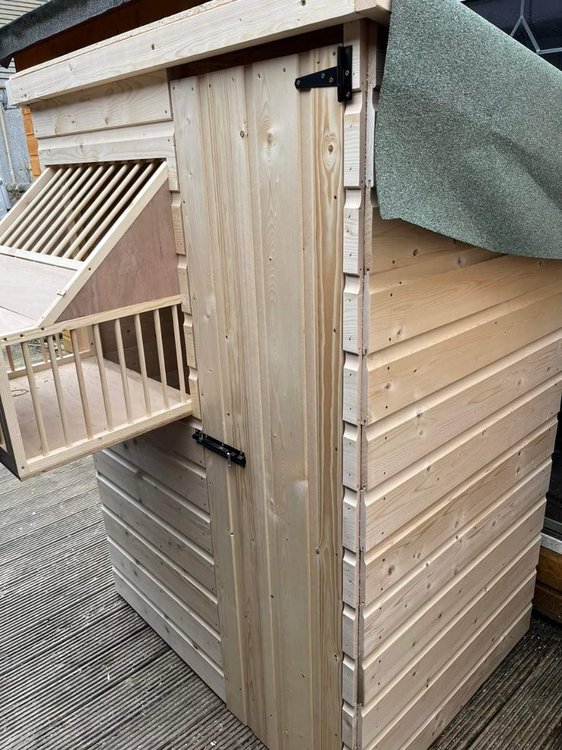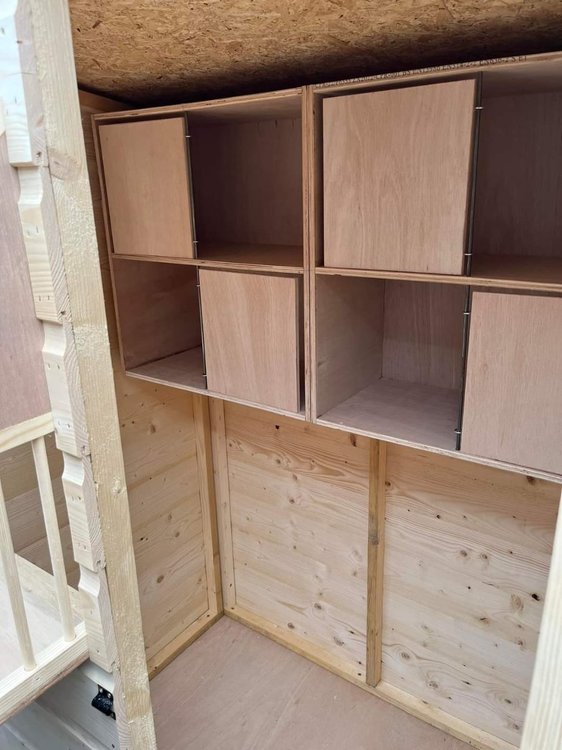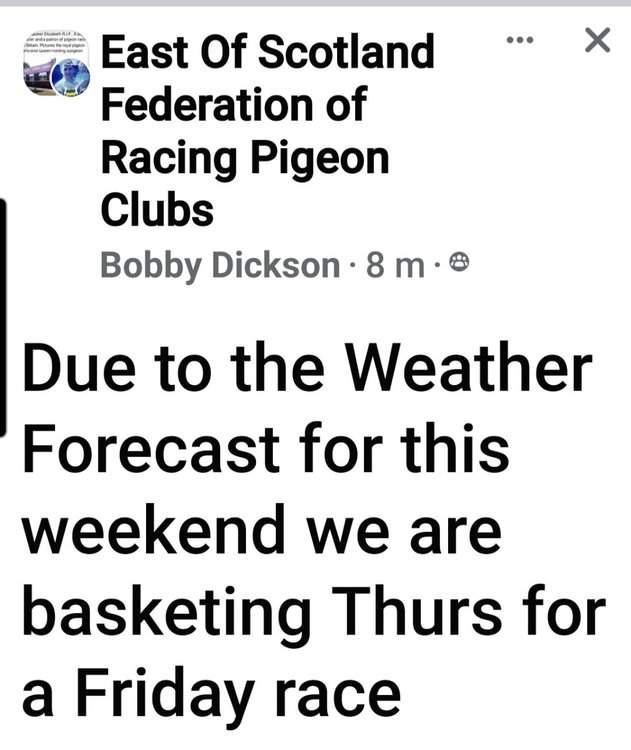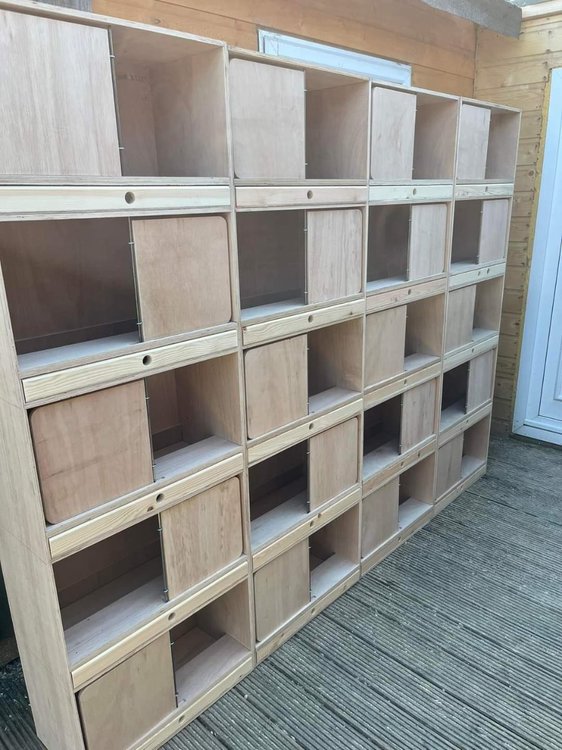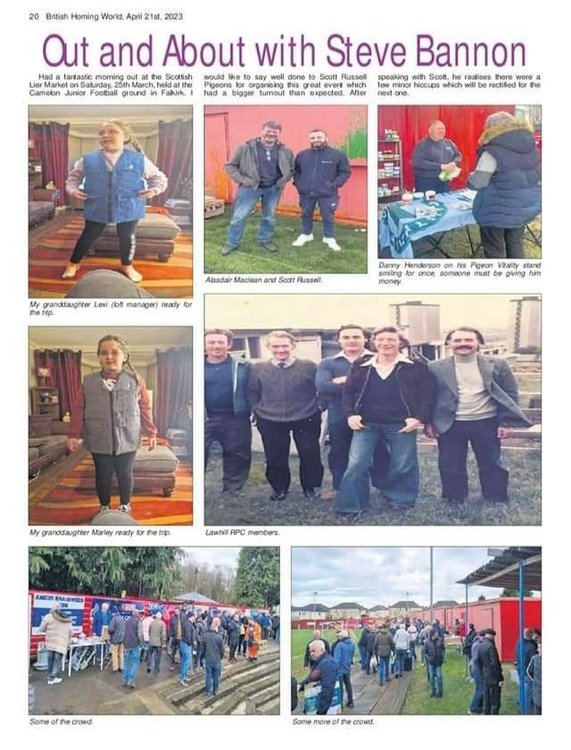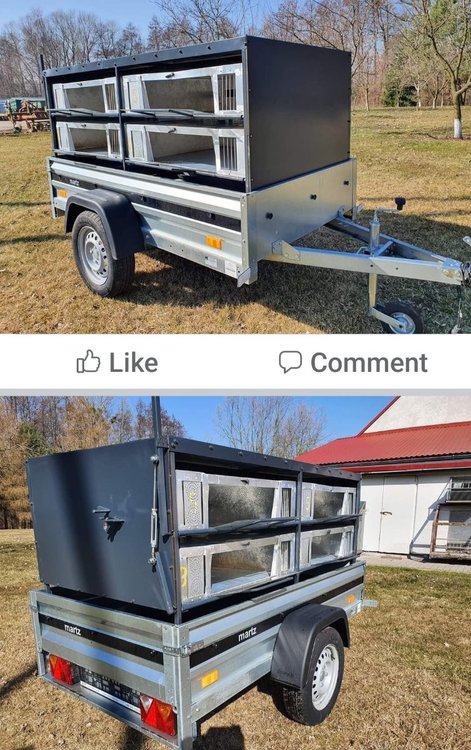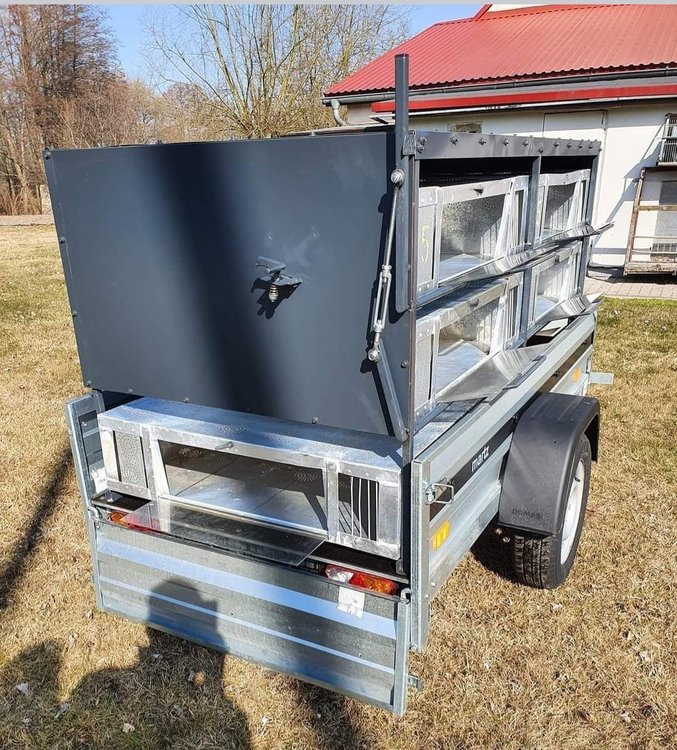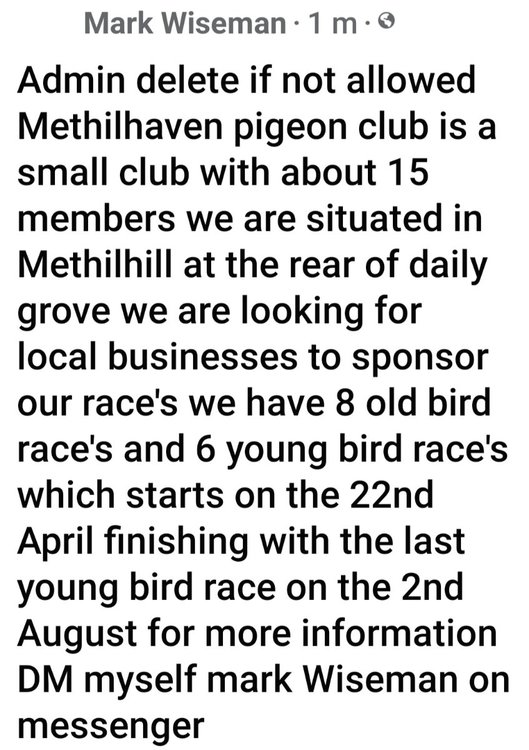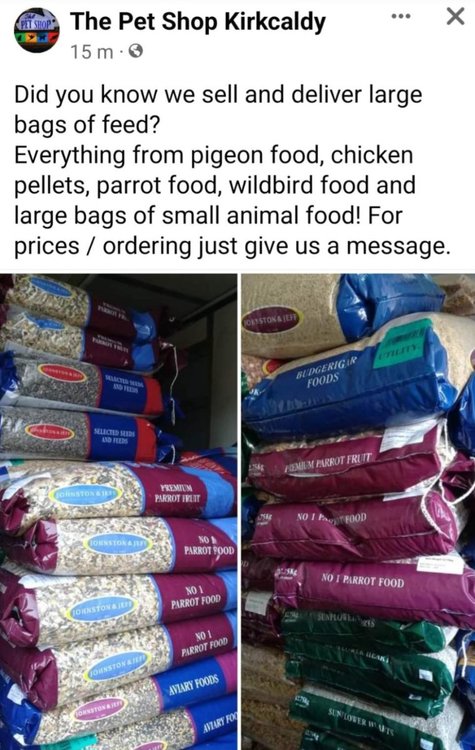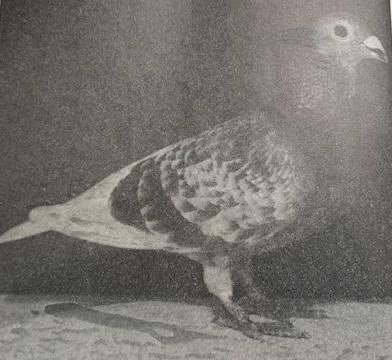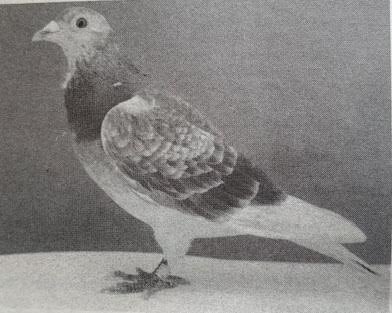-
Posts
36,138 -
Joined
-
Last visited
Content Type
Profiles
Forums
Events
Everything posted by sapper756
-
This week is the start of the 2023 season, with many federations holding their first race of the new season. If you wish to have your weekly results published in my weekly column, then I need the details by Tuesday night, as I normally spend Wednesday typing up my article and then send it away to the pigeon papers at night once I have proof read it. I you wish to add a photo of your club or federation winner, then please do so. Nowadays everyone has a mobile phone, so you can take a photo at the club hut of the winner and then email it to me at joejmurphy1@gmail.com PLEASE REMEMBER THE J in the middle of my name and the 1 at the end, you would never believe how many people tell me they sent me an email and I never printed it. I always ask did to put the J in the middle, ‘Oh I never saw that’, hence the reason I never received their email. Check this out at the bottom of my article. It is up to you the CLUBS OR FANCIERS if wish publicity for your pigeons. I look forward to hearing from my regular press officers on a weekly basis; and I wish EVERYONE all the best for the 2023 season. Best Wishes Charlie Job from Edinburgh; phoned me to say that my old workmate Stewart Peaston of South Queensferry who is 69 years old has been moved into a care home, which is very sad. Plus, the fact that his dearest friend Stewart Roberts from the same area has developed cancer. The latter moved down to Ayton and he won the young bird national 3 times in; 2000; 2001 & 2003. Jack & Stewart Peaston won 1 st & 2 nd open SNFC Avranches on the 16 th June in 1981; after a 3 -day holdover the convoy of 1334 members sent 4363 birds; were liberated at 05-45am into a North-to-North West Wind. Stewart and his dad were flying 512 miles 804 yards and their 2 birds arrived together to be timed at 20-45-16 and 20-45-20 for the only 2 pigeons recording a velocity over 1000 ypm. Both pigeons were cocks and were both blue pieds. (as a matter of interest Mr & Mrs Murphy of Kennoway won 1 st club; 153 rd east section 198 th open in this race). I did an article on Stewart and his dad in the 12 th March 1992 edition of the BHW and thought it would be good to retype this as a memento to my dear old friend. Plus, the new season will soon be upon on and my article will be about this year’s racing, so I will finish my trips down memory lane with this reminisce. Joe Murphy visits S Peaston and Son at South Queensferry -1 st & 2 nd SNFC Avranches. One of the perks of being a scribe is that you get to meet many great pigeon fanciers and to handle their birds. When these fanciers and birds have won the Scottish National Flying Club, then it makes it even greater thrill. This applies to the father and son partnership of S Peaston & son of South Queensferry won the SNFC from Avranches. Stewart the son of the partnership was a very quiet spoken person and you are not long in his company before you find out what a knowledgeable pigeon fancier his is. I met him at the Bo’ness show and asked about coming to visit him for a loft report for the paper. I travelled through to South Queensferry and was made very welcome. Stewart stays with his parents and his father Jack has allowed his some to do his own thing with the birds. As he said to me ‘He is making a good job of it so I don’t interfere’. Jack started keeping pigeons away back in 1933 but, due to moving house on the land where the loft was kept, he gave up the pigeons. In 1975 while thinking about his retirement in a few years’ time, he decided to start up again. With having a big garden, a loft was soon erected, He obtained some birds from Winchburgh club members and bought some from local auction sales in the area. He also had some birds from Jock Watson of Kirklistone fame, who was a very good SNFC flier and won a car a few years ago from France in the Combine. By this time Stewart took an interest in the birds, with others brought into the loft. Stewart purchased a pair of stock birds, after reading an article in the paper on the Workman/Baker birds that were doing very well at the distance racing. So, he sent to the Famous Louella Lofts for a pair of this family. What an investment they have been for the Peaston’s. These two birds plus a Jock Watson dark chequer hen and a Tommy Arthur ‘Smithy Cock’ have proved to be real class. The whole loft stems from these 4 birds. Both Jack and Stewart have put a lot of thought and working into their team of pigeons, read on and you will see what I mean. The stock Massarella pair, only the cock is left as the other took ill in the winter and had to be put down. This was after taking her to the vet 3 times. The partners were very sorry to see her go. The cock is a blue bar white flight with a strong back. He has a lovely feathering and is a good handler. He also had a red iris with a yellow circle. It was very dull while I was at the lofts so I didn’t get a description of the birds’ eyes. The above cock, when paired to the Massarella hen (I will call them the No 1 pair) is a blue pied cock a big bigger in the hand and a bit longer cast. He has a gap between the secondaries and primaries with his last flight longer than the ninth flight. He is a nice-looking pigeon and was on or the 3 birds I picked out when entering the loft. This cock was paired to a Jock Watson dark chequer hen. She is also a nice pigeon in the hand and she also has a big step between the secondaries and the primaries, plus a big step between the sixth and seventh flights. She also has a very black and brown yellow eye. This pair bred ‘Suspension Jack’ the national winner. Like the other birds he has a very strong back and is a big strong cock that you would think could fly forever. He also has a nice silky feathering with the step between the fifth and sixth flights. He has a red yellow coloured eye but as I said earlier, it was too dark to have a good look at the bird’s eyes. A son of ‘Jack’ has won 1 st club Penrith, 1 st Central Combine Yearling Derby from Cheltenham. He has the same characteristics as the above birds and is a very nice handler, called ‘Suspension Crack’. He in turn is the sire of a blue pied cock (My pick out of the loft along with the blue pied cock mentioned already and his brother). He is a lovely feathered bird, not too big in the hand, just right for me. He is a bull eyed pigeon, a real topper. He known as ‘Suspension Vice Versa’ the winner of 2 nd open SNFC Avranches. His dam is out of a Jock Reid hen crossed to the Tommy Arthur ‘Smithie Cock’. So, fanciers will see what I mean about how the Peaston’s have bred their birds, five generations and every one of them still in the loft. I picked out 2 hens in the loft and Stewart told me that both were bred from the Number One stock pair. Yes, a lovey team of birds and a credit to Jack and Stewart. As stated earlier, Jack gives Stewart a free hand but he helps out a lot in the loft if Stewart is away training the birds. Jack always stays at home and watches them returning home, giving them their tit- bit. Then about half an hour late, Jack will feed the pigeons. They are not believers in giving the birds big grain when returning from a toss or a race. For the start of the 1981 season the birds were paired up later than usual as the weather was very cold. They paired up on the 14 th March, 14 days later than normal. The birds have four or five tosses prior to the first race then they just go to the weekly races. Training for the nationals doesn’t start until the bird have reached Stafford, their last race, and once they are down on eggs are trained every day, weather permitting from Carter Bar. This meant getting up at 4am, and along with Tommy Arthur, going down the road with the birds, returning about 7am. Jack had their breakfast ready for them before Tommy went off to work. The training lasted about 2 and a half weeks, either from Carter Bar or Dunbar. The training was stopped two days before basketing for the Avranches race. ‘Suspension Jack’ was sitting on chipping eggs and half an hour before basketing. Stewart slipped a youngster under him. ‘Suspension Vice Versa’ was sent sitting 16 days on eggs. The birds were held over in the basket for 3 days before being liberated at 5-45am in a north – north west wind and a very steady race was forecast. It was the same wind at Carter Bar when Stewart and Tommy were down early in the morning with their Rennes birds for a toss. They both thought that if the Avranches birds were up then they would be lucky to have them home on the day. They dropped into Dougie Stewart’s house to find out if the birds were up. Like all fanciers, the birds were not far from their minds all day long and after their evening meal, the Peaston’s, along with club mate Colin Reid, settled down to watch for the birds. It became cold and quite chilly. Mrs Peaston brought out a cup of tea for the men to warm them up. When the 2 birds came over the house roof, (They had flown right up the River Forth, turning left at the Road Bridge, over the house and onto the loft). All their hearts were going at the sight of them. Both Jack and Stewart caught a pigeon each, took the rubbers off and Jack was having a bit of bother getting the thimble to close, as he had 2 tops together. (They were using a STB as their clock had stopped a couple of weeks before, so they didn’t want to take a chance with it for the National). Once they sorted out the thimbles, they were then timed in at 20-45-16 and 20-45-20, only 4 seconds between them. To be honest, they didn’t know which was bird was first into the clock with the mix up of the thimbles. They had to wait until later to find out that the old cock (77 bred) ‘Suspension Jack’ had beaten his grandson ‘Suspension Vice Versa’ a 79 bred to win the national by the drop of a thimble into the clock. The Peaston’s sent 12 birds to the race, timing 4 into the clock with 3 on the result, winning 1 st 2 nd 186 th east section, 1 st 2 nd & 238 th open, from 4363 birds. They had 11 out of 12 by midday the 2 nd day. The reason they sent the maximum of 12 birds was the amount of work they had put into the birds and they were looking that well. At about 10-30pm on the Wednesday night the SNFC secretary Bobby McLaughlin phoned to congratulate them on winning the national, with everything going ok, like the verifying the birds etc. But as the leading times were going, they would be 1 st & 2 nd . They just couldn’t believe it and couldn’t sleep that night. In fact, Stewart went for a bath at 3am to try and help him relax. As one will understand, this has been their greatest thrill, but they have had their share of disappointments as well. The one that sticks out was the death of the Massarella stock hen. But the thrills make up for the disappointments stated Stewart. The biggest influence to Jack and Stewart were the members of the Winchburgh club. They are a great lot of lads, and you to really have to go to win in this club. A lot of fanciers say that club racing does not count, well, you have got to go some in this club even to have the first bird from an national race. As Stewart says, ‘If you cannot win in your club, how do you expect to win in the federation or national? If you win in Winchburgh club you need to fear no-one. The members all work together and it’s a happy club said Stewart. He remembers the 4 th year in the club Jock Cormack from Winchburgh (one of the top fliers in the SNFC) helped train the birds as the Peaston did not have a car. That year they won 1 st club 96 th open SNFC Falaise (5967 birds). The first man to shake their hand was Jock Cormack which is typical of the man. Jock could talk pigeons all night. Stewart and Stewart Robertson went over to Jock’s loft on national night to see if he had any home or had heard of any birds timed in. They sat with Jock in his car and talked pigeons all night and before they knew it, was daylight and time for the race to open again. This is what pigeon racing is all about, and Jock Cormack was one of the all-time greats. I have missed out the sizes of the 2 lofts etc. They have just built a loft on top of their garage, 16 x 9 feet with open doors; this was for yearlings with a young bird section to be added in 1982. The yearlings were now housed in the new loft, and have settled down to it very well. Stewart put in the new loft for 4 days and then let them out. They returned to it with no problems, while Stewart was altering this loft, the birds were going in and out quite well. He says that ‘They are very inquisitive, and the building of the loft never upset the birds’ They have 4 pairs for stock birds, but also have a lot of children off them who are not raced, but are paired to a good racer, and are always kept at home for them, and they breed about 40 young birds. (I HAVE MISSED OUT THEIR FEEDING SYSTEM AS THIS HAS CHANGED SO MUCH NOW TO THE PRESENT TIME Joe Murphy) They don’t force fly their birds round the loft, they have never been believers in chasing them away from their home. If the birds were not flying when let out, then they would rather train them down the road. If an old bird that has done something special takes ill, they try to treat it, or take it to the vet, but, if young birds have anything wrong with them, they are killed. It doesn’t matter what they are bred from. It’s out!!! As Stewart feels that young birds are only as good as their next race. The birds are dewormed 3 weeks prior to pairing up and once again when the youngsters have been moved, and the birds are back down on eggs. On a Sunday they will put Milton into the water for sterilising the drinker. The birds have pic stones and a salt block plus grit and minerals before them at all times. They also give iron and multivitamins in the water and Condies Crystals in the bath water on Sunday’s, but they never give the birds that are going to the nationals a bath 2 weeks before the race. The loft is treated with Duramitex before pairing up and the inside of the loft, is painted before the birds are put together. The lofts are scrapped out every day and are very clean. They are going to try a sand litter down in the new loft, as they feel that they won’t have time to study the birds. For cleaning out 3 lofts they have tried all types of deep litter in the young bird loft with success, and feel this doesn’t put the birds up or down. They feel that the biggest asset to any loft is to have a happy and contented team of birds. Let them know that you are the boss, and keep them happy, because a happy pigeon with the loft of its loft, will give its all to get home in the long-distance races. Some advice for new starters is to look for the most consistent fancier in your area, not the one who wins one week and down the next. Get some young birds or late bred’s and build up from there. It takes time so don’t look for great things too quickly. When I asked how they would like to see the sport improve, Stewart said, ‘He would like to see the fancier who wins from 50 miles, getting the same publicity as the fancier who wins from 500 miles. He was grateful that I took the time out for a loft visit, he knows that I can’t visit everyone, but feels that all the clubs should appoint a PRO to supply scribes with weekly news and results as it’s a shame that the winners of the club don’t get publicity. The numbers of people in pigeon racing are getting fewer and fewer each year and we have got to encourage everyone in the sport, whether, they be big fanciers or not. These are true words and I wholeheartedly agree with him. Trophies won by ‘Suspension Jack’ were the Chris Catterall Trophy, John Cormack Memorial Trophy, Usher Brewery Silver Tankard, The Circle Channel Trophy, (including Central, North West and West Lothian federations). SNFC East Section trophy, and the Winchburgh Club Avranches trophy. I hope fanciers have enjoy this short story on my old mate Stewart and we wish him well. I would also like to wish his old friend Stewart Roberts all the best as well. I remember going to see his pigeons which were kept in the top part of his house, and the birds used to go in and out a big window. Stewart let us handle some of his pigeons and the body on them was outstanding, and me being me, asked to see his feeding and he showed us this big barrel of ‘Barley’, I didn’t believe him that he fed this to his birds. He swore that he did, and gave me some to take home and try it on my own birds. Which I did, I filled up hoppers with this barley, and gave the birds their normal feed in the galley pots in their boxes. Two weeks later I was handling my birds for the upcoming Avranches race, and a chequer hen handled a dream, just like Stewart Roberts birds. So, I sent her to the federation race and timed her in from 500 miles. Since then, I have always been a great advocate of feeding barley and still do so up to the present time. Best Wishes While talking to Wilf Flockhart of Tranent he was telling me that Jim Kerr of Loanhead is not very well. Jim was the secretary of Midlothian Federation at one time and he did an excellent job of it as well. Margaret and I often visited him and his wife at their home in Loanhead in the 80’s if we were over attending a pigeon auction sale; as this used to be the place most fanciers used. Jim and his wife Gina were a lovely couple; and I know many other fanciers will wish Jim their good wishes. Sad News Received an email from Rob Finlayson, who informed us of the passing of John Smith of Jedburgh in Bonchester Care Home on the 10 th of April. Rob wrote; ‘Hi Joe, as I read your column every week in the BHW I thought you may like to know (if you hadn’t heard already) about John. He was a character and will be a missed, regards Rob’. I contacted Rob and thanked him for telling me about John, he was a great character and I was very sorry to hear of his passing. Fanciers may recall my story on the famous John Kirkpatrick of Annan, who was married to John Smith’s aunt. We met up just outside Pathhead and John gifted me the famous man’s clock that he won for being 1 st open SNFC Rennes in 1937. (Ten years before I was born). Two years ago, while we were having some work done on our driveway, the foreman asked me about the clock. I explained the story to him, but said that the clock was not working now. He knew a man who lived near him who worked on clocks, and if I was agreeable, he would take it to him and see if he could get it working. A few weeks later a knock at the door and here was the foreman and the man with the clock. He said to me, ‘This is a lovely clock son and you have looked after it well as the mechanism is ‘wonderful’. I told him I had nothing to do with this as I had received the clock as a gift. He had the clock working and it has been doing so right up to the present day. It strikes on the ¼ hour and chimes on each hour. It is my pride and joy and I love hearing it every day. Now I will think of my dear friend John Smith every time I hear the clock strike the time. My thanks to Rob for notifying us of John’s passing. Rest in Peace my old friend. Joe’s Joke A farmer stopped by the local mechanics shop to have his truck fixed. They couldn't do it while he waited, so he said he didn't live far and would just walk home. On the way home he stopped at the hardware shop and bought a bucket and a gallon of paint. He then stopped at a feed store and picked up a couple of chickens and a goose. However, struggling outside the store, he now had a problem - how to carry his entire purchases home. While he was scratching his head, he was approached by a little old lady who told him she was lost. She asked, "Can you tell me how to get to 1603 Mockingbird Lane?" The farmer said, "Well, as a matter of fact, my farm is very close to that house. I would walk you there but I can't carry this lot." The old lady suggested, "Why don't you put the can of paint in the bucket, carry the bucket in one hand, put a chicken under each arm and carry the goose in your other hand?" "Why thank you very much," he said and proceeded to walk the old girl home. On the way he says "Let's take my short cut and go down this alley. We'll be there in no time." The little old lady looked him over cautiously then said, "I am a lonely widow without a husband to defend me. How do I know that when we get in the alley you won't hold me up against the wall, pull up my skirt, and have your way with me?" The farmer said, "Holy smoke lady! I'm carrying a bucket, a gallon of paint, two chickens, and a goose. How in the world could I possibly hold you up against the wall and do that?" The old lady replied, "Set the goose down, cover him with the bucket, put the paint on top of the bucket, and I'll hold the chickens." Space Weather Forecast 27-day Space Weather Outlook Table Issued 10 th April 2023 UTC Radio Flux Planetary Largest Date 10.7 cm A Index Kp Index 2023 Apr 10 140 8 3 2023 Apr 11 145 10 3 2023 Apr 12 150 14 4 2023 Apr 13 152 5 2 2023 Apr 14 155 5 2 2023 Apr 15 158 5 2 2023 Apr 16 160 5 2 2023 Apr 17 160 10 3 2023 Apr 18 160 15 4 2023 Apr 19 150 5 2 2023 Apr 20 152 20 5 2023 Apr 21 155 15 4 2023 Apr 22 155 10 3 2023 Apr 23 158 5 2 2023 Apr 24 155 5 2 2023 Apr 25 155 5 2 2023 Apr 26 152 15 4 2023 Apr 27 148 18 5 2023 Apr 28 145 15 4 2023 Apr 29 142 15 4 2023 Apr 30 140 15 5 2023 May 01 140 12 4 2023 May 02 142 10 3 2023 May 03 140 8 3 2023 May 04 135 8 3 2023 May 05 135 5 2 2023 May 06 130 5 2 You will see from the chart that this weekend 29 th & 30 th April are high readings. Please continue to keep the news flowing; to Joe Murphy Mystical Rose Cottage 2 Flutorum Avenue Thornton by Kirkcaldy KY1 4BD or phone 01592 770331 or Email to joejmurphy1@gmail.com REMEMBER THE J IN THE MIDDLE or log onto www.elimarpigeons.com www.fancierchat.co.uk www.pigeon-chat.co.uk who wish my weekly contribution portfolio on pigeon topics from Scotland © Compiled by Joe Murphy Preview attachment John Smith with the clock see text.jpg John Smith with clock. see text Preview attachment Suspension Jack see text.jpg Suspension Preview attachment Suspension Vice Versa see text.jpg Suspension Vice Versa see text.jpg 89 KB Jack see text.
-
Please post your club, Federation liberation time and where from on this post Good luck
-

Methil-Haven Pigeon Club Result Berwick 21-04-2023
sapper756 replied to cemetary's topic in Notice Board
Well done J&G Peggie Also nice to see new member JD Armour making the result -
Pentland Hills Federation liberated at 14.15 in an East Wind
-
Fife Federation pigeons liberated from Berwick this morning at 9:30am, east north east wind. Good luck to all! Jim Coltart.
-
Please post up your Liberations on this post State where from and what time Good luck
-
Where are Basics members clubs/ Federation/Organisation racing from this weekend?
-
Thanks Cemetary, mistakes do happen, I appreciate your urgency in solving this issue. Good Luck to all the purchasers with the Breeder/Buyer
-
The sale rules MUST be adhered to at all times, and I have made this clear to the Sale organisers via a PM, I am currently awaiting a response from them. I have locked this sale and I Will correspond directly via PM with the parties involved in the issue regarding lot 2 bids, and hopefully a solution is found very soon. I Will make a final comment on this post, and state that the Sale Rules clearly laid out state that for the final 30 minutes of any sale on this Forum, bids must be placed directly on Basics and therefore phone, email, text or any other bids should cease 30 minutes before end of sale.
-
-
Please feel free to post up your Club/Federation/Organisation liberation times and venues. Good Luck Folks
-
The Joe Murphy Column Received a card ‘Just to Say Thank You’ from my dear old friend Henry & Etta Mair & Family from Irvine in Ayrshire. Who wrote; It was good to read that it all worked out well with your ‘Charity’ pigeon for Blackpool. Excellent!!! Well Done. Joe your column, is a must for Anybody with pigeons in Scotland and Beyond. Keep up the Great Work, and your help from Margaret & Family. Love and best wishes Henry & Etta xx. Hendry also sent a question for my column. * How ‘close’ did Shillinglaw & Whylie pigeon ‘Blue Blitz’ come to winning 2 Gold Cups. * He was 1 st open Rennes in 1964 (6000 pigeons) * He was 2 nd open Rennes in 1965 (6000 pigeons) With Gardiner Brothers were 1 st in the race velocity 1074. * What was Blue Blitz velocity in 2 nd place???? How close was it ???? * What is the history of the Gold Cup ????? Who presented it?????? * Is G Willox of Peterhead the most northerly fancier to win it ?????? My Reply * Regarding the 1964 Rennes race; From the Rennes race 2790 members sent 5537 birds to the race the convoy were liberated at 05-35 am into a north east wind. Shillinglaw & Wylie of Newcastleton were flying 491 miles 1074 yards. They timed in their chequer hen at SU62S 6500 at 7-23-16 pm for a velocity of 1044. 2 nd open was W Gardiner of Lockerbie flying 490 miles 1040 yards timed in his chequer hen SU60S 2208 at 8-02-29pm for a velocity of 995. The FOLLOWING YEAR 1965; The convoy of 6030 birds sent by 2820 members were liberated at 6-15am at Rennes on 27 th June into a light north west wind. Winning 1 st open was W Gardiner of Lockerbie who timed in a mealy hen‘Sky Queen’ SURP61S1801 at 7-38-54 recording a velocity of 1074.0 Shillinglaw & Wylie of Newcastleton, flying 491-1074 timed in ‘Blue Blitz’ SU62S6500 at 7-40-39 recording a velocity of 1073.9 So, Henry the answer to your question was -- POINT ONE TWO OF A YARD. * What is the history of the Gold Cup ????? Who presented it ?????? My Answer; In 1913 John McAlpine, took over the managers appointment as Doctor Anderson loft. Later on, his son Willie followed in the same role. Willie celebrated his 87 th birthday during the SNFC Centenary year and probably remembered more than any other fancier about the early Nationals. Also, about Doctor Anderson and his prowess as a racer, breeder and SNFC leader. In 1914 Rennes race could have been jeopardised, as it happened Rennes went ahead in that summer despite the looming hostilities. However, that was to be the last Rennes National for some time. The Gold Cup so proudly acquired just a year earlier, was put into safe storage. The sum of £20, about half the club reserves, was placed in Government War Loans. In 1917 both Mr Dickson and Dr Anderson asked ‘To be relieved of their duties for some time’. It was perhaps rewarding that Dr Anderson was the winner of the Gold Cup in 1920; with another coincidence being that Dr Andersons near neighbours Watson Brothers won the Gold Cup. Regarding G Willox of Peterhead; Yes, he is the most northerly fancier to win the Gold Cup from Alencon in 2008 flying a distance of 631 miles, recoding a velocity of 1107. The following year 2 2009; Dave Pirie of Aberdeen won Andrezel flying 626 miles with a velocity of 1364. As a matter of pursuit Dennis Dall of Ladybank is the furthest flying SNFC record holder as he won Niort flying 697 miles in 1990; Fife had some exceptional distance fanciers in their midst at this time as John Duthie of Methil winning Niort in 1989 and Jock Traill of Thornton won Niort in 1996 and Nantes in 1997. All the above truly outstanding fanciers. In my research on my book on the Dewar Trophy winners; I came across an article in Jim Renwick’s ‘Scotland’s Own Book’, which Billy Wortley wrote. I thought some of this information is applicable to Henry Mair’s letter; so, enjoy my old friend as well as other readers of my column. …………………………………………… Jack Wylie is one of the few fanciers who became a Legend in their own lifetime, but Jack was indeed one of these people. There were a few very good fanciers who flew their pigeons in the village in that era; the most prominent was W J Little who raced Champion named ‘Border Hero’ see photo. This pigeon was a blue chequer white flight cock bred in 1951 and in 1953 won 7 th section 15 th open SNFC Rennes from an entry of 4727 birds. He was entered from Rennes in 1954 and won 1 st section 2 nd open from an entry of 5070 birds. He was back to Rennes in 1955 to win 2 nd section 14 th open from an entry of 6201 birds. Many fanciers who obtained his blood won out of turn with his offspring. In 1950 Jack Wylie became more interested in the pigeon and he would go on a Saturday to watch the pigeon’s arrival at the loft of Harkness & Fergusson. At this time Mrs Jean Shillinglaw used to visit the loft of T Robson to watch his birds return. As a matter of interest Mrs Shillinglaw was an expert in breeding and showing Border Terrier Dogs. Both Mrs Shillinglaw and her husband were each interested in the racing pigeons, and in 1962 Mrs Shillinglaw approached Jack to enquire if he was interested in starting a partnership with her. Jack agreed but as he only had a small back garden in the rear of his house, a new loft would have to be erected in the garden of Mr & Mrs Shillinglaw. In actual fact both the Wylie & Shillinglaw families were near neighbours both residing the same street North Liddle Street in Newcastleton. There were only 10 houses in the street which runs in parallel to the River Liddle. They had no problem obtaining pigeons as the club members 6 youngster to them. Two from Harkness & Ferguson, one from J Wallace and 3 from T Robson and they purchased several Logans at a sale in Balerno. Another interesting item is that 5 of the 6 original youngsters from their club mates; all scored from the channel, and one was to prove to be one of the greatest pigeons ever to compete into Scotland. One of the Harkness & Ferguson pigeons gifted to them was a blue hen SU62 6500. W J Little (mention above) who owned ‘Border Hero’ said to them that the blue hen 6500 was ‘something special’. Jack worked on the railway and was a member of the Fur & Feather Club, which entitled him to subsidise training. Jack would then train weekly from Shap or Appleby and W J Little would sit at the loft and watch the pigeons come home. W J in 1964 told Jack Wylie that the blue hen 6500 was performing well and he predicted that she would do well from the channel. Prior to going to the national she had 4 races, from Leyland; Newton of Willows; Cannock and Cheltenham. She was then entered for the SNFC Rennes Gold Cup race and the convoy were liberated at 05-35am and she was timed at 19-24 to win Scotland’s Premier race, recording a velocity of 1044ypm, and clearly won the national. A large North of England convoy was also liberated with the SNFC pigeons that day and the leading pigeon from his convoy was doing less than 1000ypm. Hence the reason she was name ‘Blue Blitz’. There was another concern regarding the National race; on the day following, J B Halliday of Brydekirk came to congratulate Jack on being the probable winner of the race, but he told Jack that he was led to believe his clock had still not arrived at the clock station for checking. In those days the birds and clocks were sent by train to the Clock Checking Station. J B’s kindly involvement prompted Jack to go to the local station in 3 Newcastleton and speak to the Station Master, who contacted Waverley Station in Edinburgh to find out if the clock had been received, and passed onto Glasgow. A further check with the Glasgow authorities confirmed the clock had been received and been passed for checking. (Could you imagine that happening now; We would be going out of our mind- who is to say that Jack Wylie wasn’t doing the same thing. The other good thing in today’s pigeon racing sport is we now have the ETS, which just shows how we have progressed over the years). In 1965 Jack Wylie gave 6500 x 3 club races in which she gained 2 federation positions and she was entered into the SNFC Gold Cup race from Rennes. The convoy was liberated at 06-15am and she was timed at 19-41pm. The outcome of the race was very close with 2 good pigeons being timed into Lockerbie. When the result came out SURP61S1801 ‘Sky Queen’ raced by Billy Gardiner timed 7-38-54 for the 490 miles 1040 yards, recording a velocity of 1074.0. Shillinglaw & Wylie of Newcastleton, flying 491-1074 they timed in ‘Blue Blitz’ SU62S6500 at 7-40-39 recording a velocity of 1073.94. The 3 rd open position was won by J McKay of Lockerbie who timed at 7-41-58 to record a velocity of 1070. So ‘Blue Blitz’ was beaten for a double SNFC Gold Cup win BY THE FLAP OF A WING. Billy Gardiner’s ‘Sky Queen’ had previously won 13 th section 25 th open SNFC Rennes 1963 with 5500 birds competing. Her daughter ‘Sky Baby’ won 1 st section 1 st open SNFC Young Bird national from Worcester in 1965 so Billy won 2 nationals in the same season. {I digress from the above a little but found these facts very interesting while doing this research. Billy Gardiner’s blue chequer hen 2208 won 16 th section 27 th open Rennes in 1965, the year previous 1964 she had won 2 nd section 2 nd open SNFC Rennes; and in 1961 this hen won 1 st club (only bird on the day of the toss) 8 th federation from Dol. Her sister was a blue pied hen named ‘Sky Princess’ who won 5 th section 13 th open SNFC Nantes in 1964 and in 1965 she won 1 st section 2 nd open SNFC Nantes, 8 th open Ushers/Vaux International} Back to another winner for Shillinglaw & Wylie was ‘Blue Booster’ winner of 1 st section 1 st open Solway Federation; they also won 1 st Solway federation averages in 1972. His dam was bred by Tom Pooley from Cockermouth while his sire was from ‘Blue Blitz’. In 1978 the partners won their 2 nd outright national winning 1 st section 1 st open SNFC Falaise with ‘Blue Boy’ which was a blue chequer cock. Mrs Shillinglaw died in 1979 and Jack moved the loft to its original location adjacent to the loft of his great friends Harkness & Ferguson. Jack recorded his 3 rd National win which was to prove quite special. After a 2-day holdover the convoy of 9983 birds were liberated at Rennes at 05- 45 am on Sunday 27 th of June into a south west wind. The loft of Shillinglaw & Wylie timed at 5- 06pm. This turned out to be as dramatic as the 1965 race, as it was a close race. Both Jack’s bird and Mr Pringle of Selkirk were recording the same velocity of 1269. Both lofts were remeasured and after several days it was announced that Shillinglaw & Wylie had won the race recording a velocity of 1269-38 and Mr Pringle velocity was 1269-35. Jack knew exactly how Mr Pringle must have felt and he had some sympathy for him, however he did appreciate; that the first telephone call he received to congratulate him was from Mr Pringle. Ever since the Rennes race was established any winner of the event wishes to do the double and in 1982 the loft of Shillinglaw & Wylie became the first loft to achieve this fete. The late president of the club Percy Cameron of Lockerbie presented Jack with a suitably inscribed Gold Watch on behalf of the SNFC in recognition of this fete. Once again, a matter of interest for fanciers. Jack Wylie favoured his cannel candidates sitting eggs or a small youngster but to illustrate the power of observation, appreciate that ‘Blue Blitz’ his 1 st open Rennes winner was sent sitting 6-day old youngsters, while ‘Liddle Supreme’ the pigeon which 4 eventually achieved the elusive 2 nd Rennes national win, was set down on chipping eggs which was his favourite next condition. ………………………………………… I hope Henry and readers of my column have enjoyed this little blast back into the history books. It is all about observation and watching and taking note of each and every one of your pigeons, be it on the nest or even if it is widowhood. The best pair of eyes in the LOFT ARE YOURS. Joe Murphy. Race Results Any club who wish to have their results in my weekly column are more than welcome to join, however I require these before Wednesday as I send my article away to the papers on the Thursday. It is up to you and if you have a photo of your club winner or their bird and wish to add this to the column, you will obtain my email and address at the bottom of my column. May I wish all fanciers who read my column ALL THE BEST FOR THE 2023 SEASON. Space Weather Forecast 27-day Space Weather Outlook Table Issued 3 rd April 2023 UTC Radio Flux Planetary Largest Date 10.7 cm A Index Kp Index 2023 Apr 03 125 8 3 2023 Apr 04 120 10 3 2023 Apr 05 120 12 4 2023 Apr 06 115 8 3 2023 Apr 07 115 5 2 2023 Apr 08 110 5 2 2023 Apr 09 110 5 2 2023 Apr 10 110 15 4 2023 Apr 11 115 12 4 2023 Apr 12 120 8 3 2023 Apr 13 125 5 2 2023 Apr 14 130 8 3 2023 Apr 15 135 8 3 2023 Apr 16 135 12 4 2023 Apr 17 135 10 3 2023 Apr 18 140 15 4 2023 Apr 19 140 5 2 2023 Apr 20 140 20 5 2023 Apr 21 135 15 4 2023 Apr 22 135 10 3 2023 Apr 23 135 5 2 2023 Apr 24 130 5 2 2023 Apr 25 125 5 2 2023 Apr 26 120 15 4 2023 Apr 27 115 18 5 2023 Apr 28 115 15 4 2023 Apr 29 115 15 4 5 Joe’s Joke No one believes seniors; everyone thinks they are senile. An elderly couple was celebrating their sixtieth anniversary. The couple had married as childhood sweethearts and had moved back to their old neighbourhood after they retired. Holding hands, they walked back to their old school. It was not locked, so they entered, and found the old desk they’d shared, where Andy had carved “I love you, Sally.” On their way back home, a bag of money fell out of an armoured car, practically landing at their feet. Sally quickly picked it up and, not sure what to do with it, they took it home. There, she counted the money - fifty thousand pounds! Andy said, “We’ve got to give it back.” Sally said, “Finders keepers.” She put the money back in the bag and hid it in their attic. The next day, two police officers were canvassing the neighbourhood looking for the money, and knocked on their door. “Pardon me, did either of you find a bag that fell out of an armoured car yesterday?” Sally said, “No”. Andy said, “She’s lying; she hid it up in the attic’. Sally said, “Don’t believe him, he’s getting senile” The agents turned to Andy and began to question him. One said: “Tell us the story from the beginning.” Andy said, “Well, when Sally and I were walking home from school yesterday ....” The first police officer turned to his partner and said, “We’re out of here!” Please continue to keep the news flowing; to Joe Murphy Mystical Rose Cottage 2 Flutorum Avenue Thornton by Kirkcaldy KY1 4BD or phone 01592 770331 or Email to joejmurphy1@gmail.com REMEMBER THE J IN THE MIDDLE or log onto www.elimarpigeons.com www.fancierchat.co.uk www.pigeon-chat.co.uk who wish my weekly contribution portfolio on pigeon topics from Scotland
-
Now that the 2023 season is underway for some, where are you racing from this Saturday?
-
I can see from posts on Facebook some clubs/Federation/Organisations start racing today. Good luck
-
The Joe Murphy Column I start off this week’s column with the sad news that Jim Sanderson of Pathhead in Midlothian; recently passed away. I had the greatest respect for Jim as he was a proper gentleman and someone, I got on very well with. He and Bobby Caruthers were the ‘Superstars’ in the 1970’s and if you were lucky enough to beat them in a national race then you would not be far from being at the top of the result. Jim was a farmer and a hard worker, so his pigeons were his hobby and a pastime to him. To his wife and family, I send my heartfelt condolences at their loss and may Jim rest in peace. Jim joined the elite in the SNFC by winning Scotland’s longest distance race 2 years in succession, he is the only fanciers within the club to win 2 consecutive SNFC Nantes races. John McGillivray & son of Forth won the SNFC from this race point in 1956 & 1958. The only other fancier to pull of the double was John Robertson of Jedburgh who won in 1970 and 1972. Jim Sanderson won 1 st open SNFC Nantes in 1976 with ‘Lady Jane’ and the following year he won 1 st open SNFC Nantes with ‘Loan Frill Lady’. So as a reverence to this wonderful fancier I’m going to reprint his 2 articles on his national wins for fanciers to read, as some readers of my column may not know of Jim or his achievements. His knowledge as a farmer and pigeon fancier may help someone in today’s sport (I hope so). In the 1982 BHW Stud Book Jim wrote an article; ‘Do Not Interfere With A Pigeon’s Natural Instincts’. In the 1983 BHW Stud Book his article was called, ‘Winning Is Sweeter- The Second Time Around’. Jim wrote the following articles; ‘I would like to than the Editor of the BHW for acknowledging my performance in the SNFC Nantes race by asking me through Joe Murphy, BHW Scribe for Fife, to contribute this article. It was for me a thrill of a lifetime to win Scotland’s longest national race. Having come close to winning – 4 th open Avranches in 1976, and 7 th open Nantes in 1980, I thought I knew the excitement of doing well in a national race. In fact, nothing can compare to the feeling of actually winning and I consider myself extremely fortunate indeed to experience this. ‘Lady Jane’ is a 1976 late bred. As a yearling she was given 5 races to a distance of 150 miles, and then stopped. Then as a 2-year-old she went out to Dorchester 350 miles, and then onto 500 miles for Avranches. In this race she finished just out of the prize money. Liberated at 06-15am into a west wind, I timed her in at 22-30 in very good condition for 16 ¼ hours on the wing. Her full sister won 91 st open in this race. On now to 1979 when I decided to prepare ‘Lady Jane’ for Rennes, in this race she gained 116 th open at a velocity of 824 for the 540 miles. The following year, in the same race she was my nominated pigeon, and I gained 41 st , 98 th , 146 th & 314 th open, all on the day. But ‘Lady Jane’ was not one of these. This I could not understand, until the following morning, at 06-00 she arrived home with all the feathers missing out of her back and blood everywhere. She had I think she had been attacked by a hawk, but whatever happened she had shown great courage in getting home. The following season in 1981, I decided to prepare her for Nantes, and watched her carefully on her arrival back from club races, to make sure she was suffering no after affects, from her expedience at Rennes the previous year. All seemed well, so along with the other 4 in my team, she was prepared for Nantes, with club races of 150, 200, & 250 miles. After having settled on her eggs, she was given as many 40-mile tosses as time allowed. On the day of basketing she had been sitting 15 days. The Nantes birds were liberated at 09-15am, ‘Lady Jane’ was timed at 21-13 with a velocity of 1469 ypm for 600 miles. (to win the race JM) Another of the team, took 22 nd open and the rest of the 5 birds were home by 9-30 the following morning, having taken 43 rd & 61 st open Rennes the previous weekend. This concluded a very exciting week for me. 2 Lady Jane’s’ sire, is a red chequer cock, which I have always kept for stock, he was kindly given to me by my cousin Alec Allison of Carnwath, who is one of Lanarkshire’s top national fliers. ‘Young Scalpy’ has proved to be an outstanding stock bird directly responsible for 8 SNFC certificates so far. His unusual names come from his mother, as a nestling, she was badly pecked about the head by an intruder in the nest box. Beryl- Alec’s wife, nursed her back to heath, and christened her ‘Scalpy’. She went on to take many prominent positions, in national races, and was an outstanding stock bird. ‘Lady Jane’s’ dam had only one race from France taking 175 th open Rennes in 1973, and then because of her breeding she was then retired to stock. Her bloodlines go back to J McGilvery of the Forth, a previous double winner of the Nantes race. My loft is 18 feet by 7 feet with 24 pairs including the stock pairs. After the 1980 racing season I put down for the first time a deep litter of Spanish Clay granules; the birds took to it immediately, in fact a lot quicker than their owners, after being a scraper man for 19 years, I still find it difficult to get used to the deep litter, but if the pigeons like it then that is all the matters. My feeding methods are very simple, I give the birds a mixture, maize and wheat, 3 times each day, and there are always some beans in the hoppers. I believe one should vary the contents of the mixture with regard to the work the pigeons are doing, since muzzle require energy for sustained work. As far as exercise is concerned, I am very fortunate being able to give my birds an open loft all day. I feel the benefit of this is not so much, the exercise but the fact that it is a more natural state for the pigeons to live in. They are very content flying out and in as they please. One danger of this system can be poisoning in the fields at certain times of the year. Being a farmer, I know these times and I keep the birds shut in. The management of my loft is geared completely towards the National races. With my system of always breeding ONLY from PRIZE WINNERS, in these National races. I now feel that I have a family that gives me more than a reasonable chance of scoring. I do enjoy young bird racing but use it only as a means of weeding out and giving experience to the babies. They are given every race through to our last federation open race, which is about 200 miles. Unfortunately; I have not often been able to fly the yb national race; this is due to the fact the it takes place around harvest time, and then the farm takes precedence over the pigeons. Finally, to sum up, I would like to say, that I feel we should always remember that the pigeons have natural instincts and responses. To try and interfere with these is courting disaster, I feel we are more than half way to success if we use these instincts and responses intelligently, gaining the complete confidence of the birds. While compiling my article for the 1981 year book, I never imagined I would be doing the same in 1982. To win Nantes again, and thus create a record for the first person do this in consecutive years, seems quite unbelievable to me. I have been asked by many fanciers how this feel, but I find it hard to put into words. Last year I had a feeling of excitement for many weeks on winning my first national, this year, it was still very exciting, but I have more a sense of satisfaction in that it was a completely different type of race. In 1981, it was a fast race with many birds’ home on the day, 1982 was quite opposite, with no bird’s home on the day. In fact, very few birds homed before lunchtime the second day. ‘Loan Frill Lady’ landed at 05-51am to win with 30 minutes to spare flying 599 miles. ‘Loan Frill Lady’ is a small to medium hen, with a little frill on her chest. She was bred in 1976 and raced to 212 miles as a young bird. In 1977 after a very bad race from Worchester, 250 miles, she took 2 weeks to return, but that was her last mistake. In 1978 she flew Rennes but was just out of the clock. In 1979, I put her to Nantes where she took 35 th open, then Nantes again in 1980, where she was even better winning 6 th section 7 th open. In 1981 the year ‘Lady Jane’ won; ‘Loan Frill Lady’ just missed the prizes. Then this year she wins 1 st open. For me her performances over the last 4 years make her one of Scotland’s Nantes birds. Last year I wrote about my management and methods in the loft, this year I would like to make a few comments and observations on breeding. While racing takes dedication, hard work and time, 3 breeding takes constant study of the birds and their pedigrees. There are many champion racing pigeon fanciers, but like good breeding pigeons, champion breeders are THIN ON THE GROUND. The reason for this I feel, is that the top breeder has a kind of sixth sense when it comes to pairing birds. He cannot explain it, but I would put it down to ‘stock sense’ on the other hand being a successful breeder does not always result in being a successful racer. In this case perhaps the man with the stock sense lacks the dedication of the racer. One hears many arguments about inbreeding or line breeding verses cross breeding, with each exponent convinced his way is right. Personally, I prefer to take a middle road. Being extreme in anything seldom gets you anywhere, and especially not in the world of pigeon racing. Obviously, to establish a family of consistent racers you have to inbreed. I do this, but only with the best of specimens, and with pigeons that have flown 500 miles more than once. I only go really close to get my stock birds. I do a bit of crossing as well. Whenever I feel my family needs an injection of fresh blood, to give it extra vigour and stamina, or I need to correct a fault that is creeping in, I cross breed. The cross MUST BE a similar type to my own and come from a family consistently winning at 500/600 miles. The young of the first cross MUST WIN- I do not wait until the next generation. The whole idea of a cross is to give your family a lift, and if it cannot do it immediately then out it goes. My really outstanding racers such as Loan Frill Lady are from a first cross. Her sire was bred by W Brown of Peebles, while her dam is my 1298 hen, who is the mother and great dam of my whole loft, and closely inbred to my original stock. This would suggest that one should inbreed for stock and outcross for good racers. In last year’s article, I also said I only keep 4 pairs of stock birds. Good stock birds are both hard to breed and to find. My own requirements in a bird under consideration for stock are as follows – It must come from a long line of pigeons that have won at 500/600 miles, and conform to my standard of physique. This includes a strong back and rump but not too deep in the keel, and showing an abundance of pectoral muscles. I like a pigeon to have a nice supple wing with the last 4 primaries narrower than the others, thus showing gaps between them similar to the 4 fingers of your hand. The secondaries should be broad and of medium length, and, is the case with all top pigeons, the feathers should be smooth and feel like velvet. The pigeon must come into my hand every easily, immediately feeling both balanced and buoyant in them. This feeling is difficult to describe with words, but I know instinctively whenever I handle a pigeon, if it is of the type I like and think ‘should win’. Lastly, I like to see my stock birds with eyes of rich pigmentation, whatever the colour. Even after passing all the above requirements, in the end, a top stock cock is judged by how many winners it breeds. Some of you after reading this, will say ‘But they breed and race in ALL shapes and sizes. This to a point is correct. However, we must remember that this sport of ours is supposed to be a hobby giving lots of pleasure. With this in mind, I decided many years ago that if I was going to win it would be with the type of pigeon I LIKED. I am sure you will agree with me that I say, it gives TWICE THE PLEASURE, TO WIN WITH A PIGEON WE FANCY, as opposed to one we do not. Before finishing, I would like to illustrate a point I made last year. I stated that it was very important to gain the confidence of your pigeons. An example of this is ‘Loan Frill Lady’. During the racing season, after their evening meal, I give them a few seeds in their nest boxes. Now, whenever I go for the tin of seeds, which I keep, just beside the bucket where I sit to watch my pigeons, along come ‘Lady’. Even if she is sitting, she still comes, and I give her a few seeds, stroking her chest at the same time. To me, she is a little friend, but more importantly, I think I am HER FRIEND. Joe’s Joke The Sensitive Man A woman meets a man in a bar; they talk; they connect; they end up leaving together. They get back to his place, and as he shows her around his apartment. She notices that one wall of his Bedroom is completely filled with soft, sweet, cuddly teddy bears. There are three shelves in the bedroom, with 4 hundreds and hundreds of cute, cuddly Teddy bears carefully placed in rows, covering the entire wall! It was obvious that he had taken quite some time to lovingly arrange them and she was immediately touched by the amount of thought he had put into organizing the display. There were small bears all along the bottom shelf, Medium-sized bears covering the length of the middle shelf, and huge, enormous bears running all the way along the top shelf. She found it strange for an obviously masculine guy to have such a large collection of Teddy Bears, she is quite impressed by his Sensitive side. But doesn't mention this to him they share a bottle of wine and continue talking and, after a while, she finds herself thinking, "Oh my God! Maybe, this guy could be the one! Maybe he could be the future ‘Father of my children?" She turns to him and kisses him lightly on the lips and he responds warmly. They continue to kiss, the passion builds and he romantically lifts her in his arms and carries her into his bedroom where they rip off each other's clothes and make hot, steamy love. She is so overwhelmed that she responds with more passion, more creativity, more heat than she has ever known. After an intense, explosive night of raw passion with this sensitive guy, they are lying there together in the afterglow. The woman rolls over, gently strokes his chest and asks coyly, "Well, how was it?" The guy gently smiles at her, strokes her cheek, looks deeply into her eyes, And says: "Help yourself to any prize from the middle shelf" Please continue to keep the news flowing; to Joe Murphy Mystical Rose Cottage 2 Flutorum Avenue Thornton by Kirkcaldy KY1 4BD or phone 01592 770331 or Email to joejmurphy1@gmail.com REMEMBER THE J IN THE MIDDLE or log onto www.elimarpigeons.com www.fancierchat.co.uk www.pigeon-chat.co.uk who wish my weekly contribution portfolio on pigeon topics from Scotland
-
Good luck with your sale
-
Good luck with your sale



